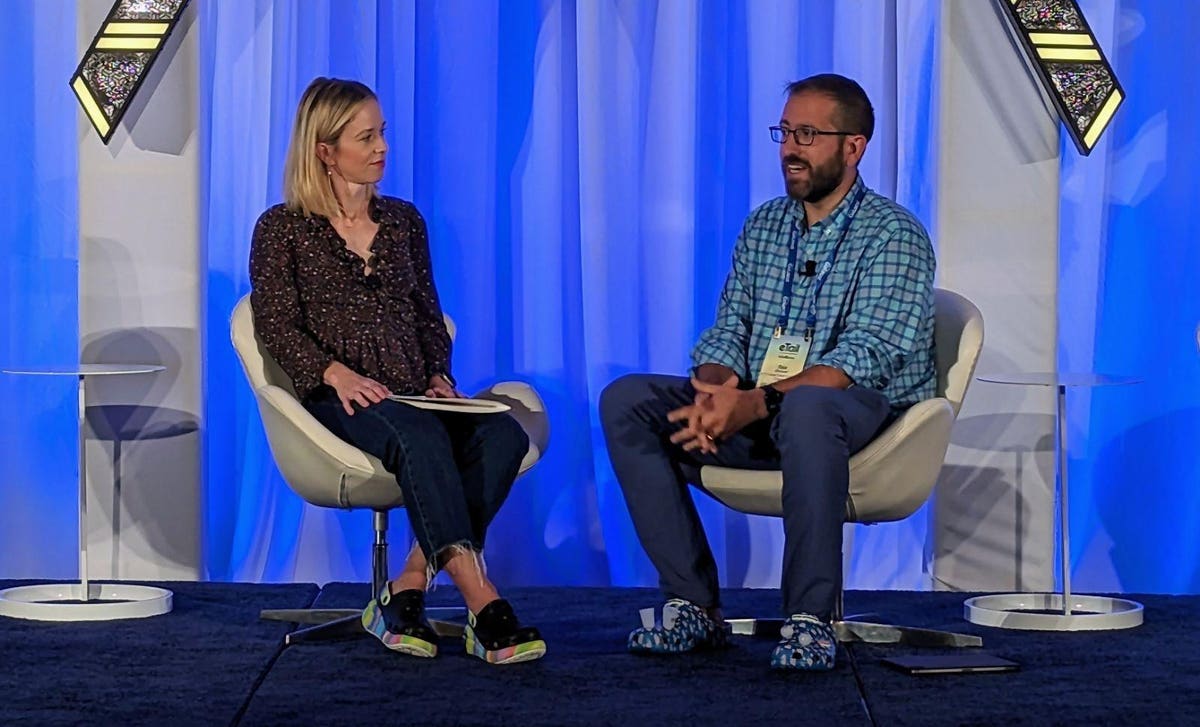There are few brands in the footwear world as iconic as Crocs. These clogs are beloved by schoolchildren, nurses, chefs for their durability and comfort, and have also proven durable in the cultural Zeitgeist.
But this popularity makes Crocs a ripe target for knockoffs and gray market resellers in many sales channels, particularly online retail marketplaces like Amazon
AMZN
Dan Marques is the SVP, Global Digital Commerce at Crocs. Part of Marques’ remit is overseeing the team that handles marketplace control, which received a specific call-out on Crocs’ Q2 earnings call as being a top priority for the recently acquired Hey Dude brand.
I interviewed Marques at eTail’s Boston event this week, where he had paired his Vineyard Vines x Crocs collab shoes with beer pong themed Jibbitz. Here is an abridged version of that conversation.
As SVP of Global Digital Commerce at Crocs, what is your purview within the company?
I joined Crocs almost four years ago. What’s unique at Crocs, and one of the reasons I was excited to join was they already had this perspective of it’s not about “e-commerce”, it’s about digital commerce.
That means all the touch points with the consumer in digital. For a lot of brands, particularly in footwear, you might have a different team responsible for online wholesale accounts like Zappos, versus a different team for marketplaces like Amazon and eBay, and a different team response for ecommerce. In the case of Nike
NKE
But at Crocs we believe that it needs to be all integrated. We are one digitally integrated digital commerce team that manages all our online sales channels (marketplaces, online wholesale partners, and our .com site and app), our regions around the globe, and two brands.
Crocs has an enormous assortment, between all the styles, colorways, licensed products and, jibbitz. Some brands with large assortments like this choose to carry just their core assortment on marketplaces and then their drops or extensions through their own channels. How do you think about assortment across your channels?
We have a consumer-first lens in how we think about our assortment and segmentation.
We want Crocs.com to be the best representation of our brands, including the hottest and newest drops like our Lightning McQueen drop this week, which started on our .com site. And there’s even more special releases on our app.
For each channel and partner, whether that’s Amazon or a Dick’s Sporting Goods
DKS
We’ve done some pretty cool collaborations and license activations with retailers. We partnered with Zappos, for instance, to launch a Savannah Bananas themed shoe. A lot of brands would not do this kind of thing. But for us, it’s a great way to create a win-win situation with activating our audience and their audience.
I’m curious about the knockoff Crocs that we come across on Amazon, for example. Are these a concern for you?
We take our brand and our intellectual property and designs very seriously. And we enforce those everywhere. As our brands become more popular, there’s obviously a proliferation of knockoffs.
So we went out to see how other brands are tackling this – anything from high-end purses, Rolex watches, other footwear brands. We didn’t find a cohesive, integrated approach anywhere. There might be someone in the legal department who’s doing some stuff, there might be someone on a wholesale team, sometimes there’s someone in digital who’s focused on this.
But there really wasn’t any other brand with a model that would made sense to us. So late last year, we built what we call a marketplace management team that sits within digital.
We view all of these things as part of managing the digital marketplace: dealing with frauds and counterfeits, to knock offs that violate our IP, to online distribution, to who’s allowed to sell online, inventory tracking, factory tracking.
All of us – including me – have learned a lot in the past year, becoming supply chain detectives using different tracking solutions and different ways to understand how these products get created, how they show up on Amazon and other marketplaces, and understanding what the options are to mitigate it. It is now a multi-person, full time effort, with multiple technology tools and platforms, and multiple agencies and legal teams supporting us on this. So it’s become a pretty big effort that we take really seriously.
The job is never done.
I see a lot of effort into brand content and product content on Amazon in particular from Crocs. How do you rationalize the investment there?
I’ve spoken with other DTC brands that say they don’t want to work with Amazon for various reasons and only want to have our product available on their .com site.
But when you consider that two thirds of all ecommerce transactions happen on a marketplace somewhere around the world, whether that’s Amazon or Tmall, you’re missing out. It’s the largest search engine for product searches and Crocs. So you’re missing a large opportunity by not participating.
There’s a phase beyond that where a brand chooses to engage with marketplaces, but only in a small subset of their assortment, and the approach is “set it and forget it.” That’s the most common approach I see.
But at Crocs we have built a team which is not just a one-person job. There’s a whole operational component to track what’s best in class, and all the fulfillment requirements, customer service, and all the KPIs around that.
We have a whole team dedicated to maximizing opportunities on marketplaces and etail accounts. That might be a mix of internal and external team members and agencies to make that happen. Then we can go after all these different opportunities, including the beta programs or things we can test out. We take advantage of everything we can – messaging platforms, influencer programs – we test it and see what makes sense for us.
It’s often challenging to measure an ROI on something like this – is there a metric that you think about with content?
Since you don’t own the data, the measures won’t be as clear as your own website. But to the degree possible, we try to understand the impact that these pages are having in the journey, and any revenue we contribute to them. We’ve definitely proven that this investment yields a great return for us.
Read the full article here





